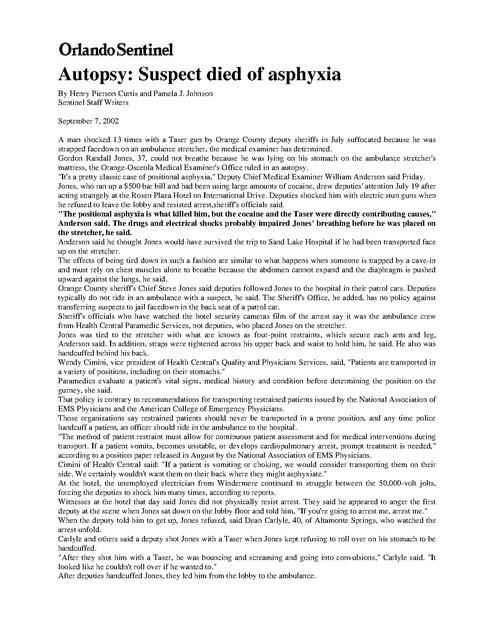Taser Orange Co Fl In-custody Death Asphyxia 2002
Download original document:

Document text

Document text
This text is machine-read, and may contain errors. Check the original document to verify accuracy.
OrIandoSentinel Autopsy: Suspect died of asphyxia By Henry Pierson Curtis and Pamela J. Johnson Sentinel Staff Writers September 7, 2002 A man shocked 13 times with a Taser gun by Orange County deputy sheriffs in July suffocated because he was strapped facedown on an ambulance stretcher, the medical examiner has determined. Gordon Randall Jones, 37, could not breathe because he was lying on his stomach on the ambulance stretcher's mattress, the Orange-Osceola Medical Examiner's Office ruled in an autopsy. "It's a pretty classic case of positional asphyxia," Deputy Chief Medical Examiner William Anderson said Friday. Jones, who ran up a $500 bar bill and had been using large amounts of cocaine, drew deputies' attention July 19 after acting strangely at the Rosen Plaza Hotel on International Drive. Deputies shocked him with electric stun guns when he refused to leave the lobby and resisted arrest,sheriff's officials said. "The positional asphyxia is what killed him, but the cocaine and the Taser were directly contributing causes," Anderson said. The drugs and electrical shocks probably impaired Jones' breathing before he was placed on the stretcher, he said. Anderson said he thought Jones would have survived the trip to Sand Lake Hospital if he had been transported face up on the stretcher. The effects of being tied down in such a fashion are similar to what happens when someone is trapped by a cave-in and must rely on chest muscles alone to breathe because the abdomen cannot expand and the diaphragm is pushed upward against the lungs, he said. Orange County sheriff's Chief Steve Jones said deputies followed Jones to the hospital in their patrol cars. Deputies typically do not ride in an ambulance with a suspect, he said. The Sheriff's Office, he added, has no policy against transferring suspects to jail facedown in the back seat of a patrol car. Sheriff's officials who have watched the hotel security cameras film of the arrest say it was the ambulance crew from Health Central Paramedic Services, not deputies, who placed Jones on the stretcher. Jones was tied to the stretcher with what are known as four-point restraints, which secure each arm and leg, Anderson said. In addition, straps were tightened across his upper back and waist to hold him, he said. He also was handcuffed behind his back. Wendy Cimini, vice president of Health Central's Quality and Physicians Services, said, "Patients are transported in a variety of positions, including on their stomachs." Paramedics evaluate a patient's vital signs, medical history and condition before determining the position on the gurney, she said. That policy is contrary to recommendations for transporting restrained patients issued by the National Association of EMS Physicians and the American College of Emergency Physicians. Those organizations say restrained patients should never be transported in a prone position, and any time police handcuff a patient, an officer should ride in the ambulance to the hospital. "The method of patient restraint must allow for continuous patient assessment and for medical interventions during transport. If a patient vomits, becomes unstable, or develops cardiopulmonary arrest, prompt treatment is needed," according to a position paper released in August by the National Association of EMS Physicians. Cimini of Health Central said: "If a patient is vomiting or choking, we would consider transporting them on their side. We certainly wouldn't want them on their back where they might asphyxiate." At the hotel, the unemployed electrician from Windermere continued to struggle between the 50,000-volt jolts, forcing the deputies to shock him many times, according to reports. Witnesses at the hotel that day said Jones did not physically resist arrest. They said he appeared to anger the first deputy at the scene when Jones sat down on the lobby floor and told him, "If you're going to arrest me, arrest me." When the deputy told him to get up, Jones refused, said Dean Carlyle, 40, of Altamonte Springs, who watched the arrest unfold. Carlyle and others said a deputy shot Jones with a Taser when Jones kept refusing to roll over on his stomach to be handcuffed. "After they shot him with a Taser, he was bouncing and screaming and going into convulsions," Carlyle said. "It looked like he couldn't roll over if he wanted to." After deputies handcuffed Jones, they led him from the lobby to the ambulance. Outside, Jones was placed on the ground facedown. Jones mumbled to deputies, "I love you guys. Why are you doing this to me?" Carlyle said. "He never fought one time; he never did," Carlyle said. After Jones started foaming at the mouth, authorities cleared the front of the hotel, where about 20 people were gathered, Carlyle said. Cimini declined to comment about whether a patient foaming at the mouth might be transported on his side, except to say, "Foaming at the mouth is not the same as vomiting." She said she was not aware of any training that paramedics undergo involving patients who have been shot with Tasers. Jones' sister, Cheryl McAllister, 41, of St. Cloud, said she was devastated by the autopsy findings. The Jones family hired an attorney after Jones' death. "To know my brother was strapped down on his stomach with his face down and couldn't move -- it's like reliving the pain all over again," McAllister said. "These past six weeks have been hell." Henry Pierson Curtis can be reached 407-420-5411 or hcurtis@orlandosentinel.com. Pamela J. Johnson can be reached at pjohnson@orlandosentinel.com or 407-420-5171.

